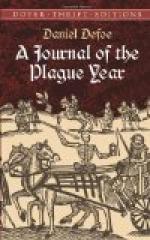By this, however, the number of people in the whole may be judged of; and, indeed, I often wondered that, after the prodigious numbers of people that went away at first, there was yet so great a multitude left as it appeared there was.
But I must go back again to the beginning of this surprising time. While the fears of the people were young, they were increased strangely by several odd accidents which, put altogether, it was really a wonder the whole body of the people did not rise as one man and abandon their dwellings, leaving the place as a space of ground designed by Heaven for an Akeldama, doomed to be destroyed from the face of the earth, and that all that would be found in it would perish with it. I shall name but a few of these things; but sure they were so many, and so many wizards and cunning people propagating them, that I have often wondered there was any (women especially) left behind.
In the first place, a blazing star or comet appeared for several months before the plague, as there did the year after another, a little before the fire. The old women and the phlegmatic hypochondriac part of the other sex, whom I could almost call old women too, remarked (especially afterward, though not till both those judgements were over) that those two comets passed directly over the city, and that so very near the houses that it was plain they imported something peculiar to the city alone; that the comet before the pestilence was of a faint, dull, languid colour, and its motion very heavy, Solemn, and slow; but that the comet before the fire was bright and sparkling, or, as others said, flaming, and its motion swift and furious; and that, accordingly, one foretold a heavy judgement, slow but severe, terrible and frightful, as was the plague; but the other foretold a stroke, sudden, swift, and fiery as the conflagration. Nay, so particular some people were, that as they looked upon that comet preceding the fire, they fancied that they not only saw it pass swiftly and fiercely, and could perceive the motion with their eye, but even they heard it; that it made a rushing, mighty noise, fierce and terrible, though at a distance, and but just perceivable.
I saw both these stars, and, I must confess, had so much of the common notion of such things in my head, that I was apt to look upon them as the forerunners and warnings of God’s judgements; and especially when, after the plague had followed the first, I yet saw another of the like kind, I could not but say God had not yet sufficiently scourged the city.




